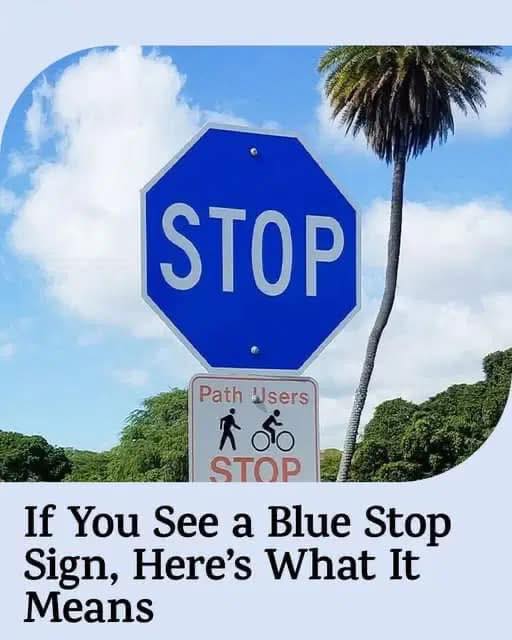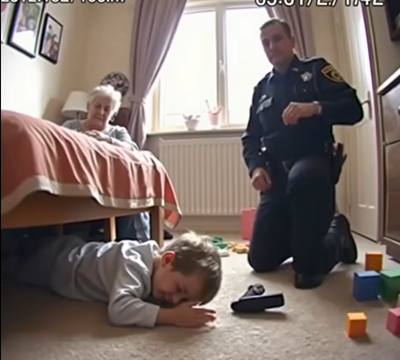We’re all familiar with the standard red stop sign, a staple of traffic control in the United States and around the world. From childhood lessons on road safety to everyday driving experiences, the red octagonal sign is a universally recognized symbol commanding drivers to halt before proceeding. However, some drivers may be surprised to encounter a blue stop sign. While rare, these signs do exist in certain locations. But what do they mean, and where can they be found?

What Does a Blue Stop Sign Indicate?
In the United States, a blue stop sign still means that drivers must come to a complete stop before moving forward. Despite its similarity in shape and purpose to traditional red stop signs, blue stop signs are not issued by state or federal transportation agencies and are not considered official traffic control devices. Instead, they are typically used in private areas to indicate stopping points, serving the same fundamental purpose as standard red stop signs.
Since the 1950s, the Federal Highway Administration’s Manual on Uniform Traffic Control Devices (MUTCD) has required all official stop signs in the U.S. to be red. The choice of red was based on its high visibility and the need for a standardized national approach to traffic signage. This ensures that stop signs are easily recognizable, reducing confusion for drivers.
Blue stop signs are not found on public roads in the United States but do appear in other countries, often to indicate restricted access or no-entry zones rather than standard stopping points.
Where Are Blue Stop Signs Used?
In the United States, blue stop signs are primarily seen on private properties. Large estates, ranches, golf courses, country clubs, and other privately owned areas sometimes use blue stop signs to regulate internal traffic flow. Hawaii, in particular, has a notable number of blue stop signs due to state regulations that prohibit official road signs on private property. In such cases, property owners opt for blue stop signs to direct drivers without violating local laws.
@.thenewwave♬ original sound – The New Wave
Outside the United States, blue stop signs can be found in countries like Japan, South Korea, and Mexico. However, their meaning varies. Rather than signaling a mandatory stop followed by the option to proceed, these blue signs often indicate restricted zones or no-entry areas. In these cases, blue stop signs instruct drivers to turn around rather than continue forward.
Even in countries where blue stop signs are used, the standard red octagonal stop sign remains the primary symbol for stopping traffic. In 1968, the United Nations introduced international road sign regulations to enhance safety across different jurisdictions. These global standards include the red stop sign, which remains the most commonly recognized traffic control sign worldwide.
Can I Install a Blue Stop Sign Near My Home?
If you own a large private property with an internal roadway system, you can install a blue stop sign. According to traffic regulations, blue stop signs are not authorized for use on public roads in the United States. For example, in Massachusetts, and similarly in other states, only officially recognized traffic control devices are permitted on municipal or state roads. This means that while blue stop signs are acceptable for private property use, they cannot legally be placed on public streets.
Another consideration is whether blue stop signs hold any legal authority. Unlike standard red stop signs, which are enforceable by law, blue stop signs are often seen as advisory rather than mandatory. However, they still serve a purpose. If you encounter a blue stop sign on private property, it has likely been placed there for a reason. Drivers should treat them as legitimate stop signs, pausing and ensuring the area is safe before proceeding.
The Purpose of Blue Stop Signs
The primary reason for using blue stop signs is to distinguish them from official traffic control devices. Because red stop signs are regulated and standardized, using a different color allows private property owners to manage their traffic flow without misrepresenting an official road sign. Whether on private land in the U.S. or used for specific traffic directives in other countries, blue stop signs serve as an alternative method of traffic regulation.
Conclusion
While blue stop signs are not standard on public roads, they still play a role in traffic management in private settings. In the U.S., they are used primarily on private properties like estates, golf courses, and ranches, helping guide vehicles without violating federal or state regulations. In some international locations, blue stop signs have different meanings, often indicating restricted zones or no-entry areas rather than traditional stopping points.
If you come across a blue stop sign, it is best to treat it like any other stop sign—pause, check for oncoming traffic or hazards, and proceed when it is safe. Although they are not legally enforceable in the same way as red stop signs, they are still placed with a purpose in mind. Understanding their meaning can help drivers navigate unfamiliar areas more confidently, ensuring safety on both public and private roads.





